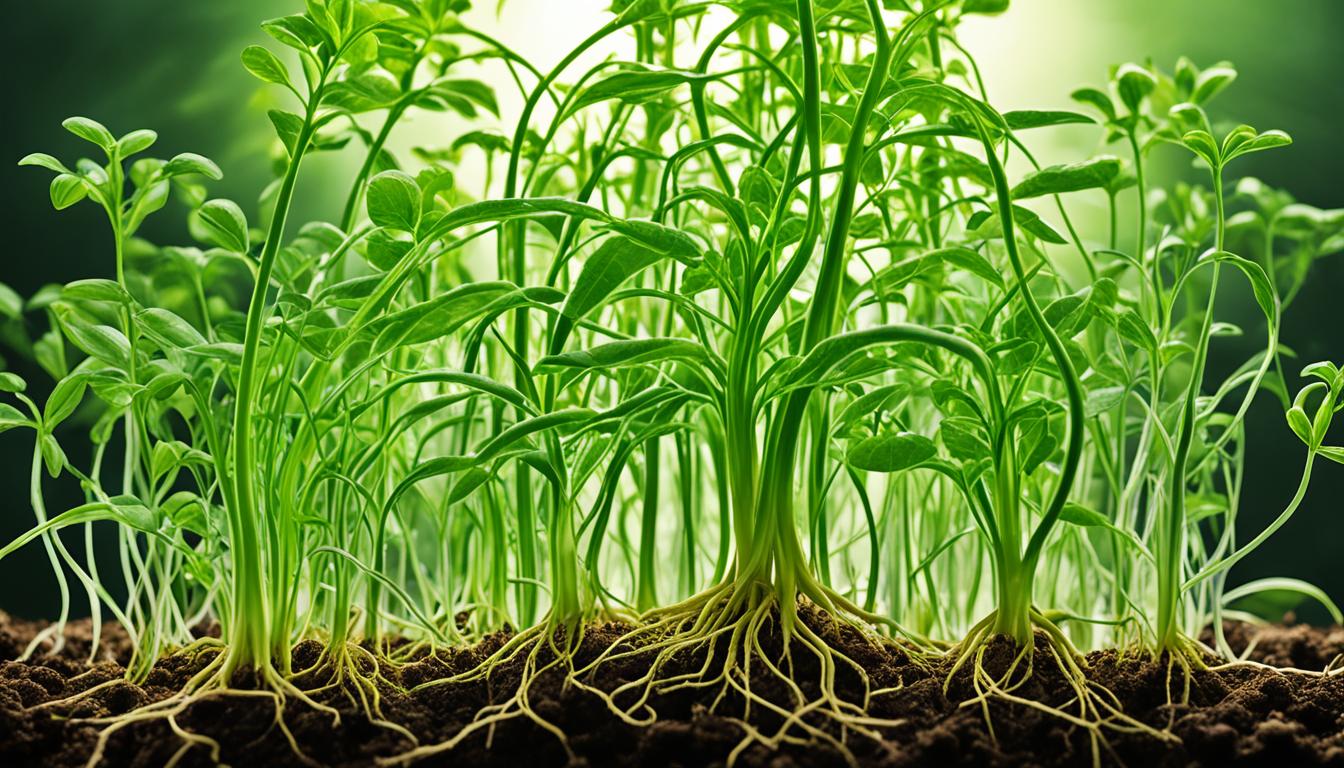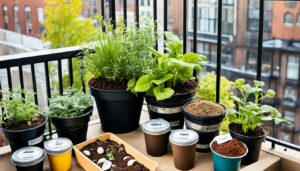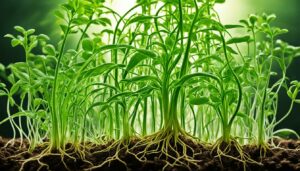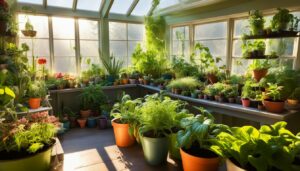Cytokinins, powerful phytohormones, shape a plant’s response to its environment by up to 70%. They control key aspects of growth and development, like keeping shoot apical meristems dynamic and determining leaf shape and aging. This makes them essential for a plant’s entire life cycle. By adjusting how cytokinins are made and used, plants can do well in different climates. The more we learn about these hormones, the more we can improve farming and gardening.
Key Takeaways
- Cytokinins are crucial phytohormones in regulating plant growth and development.
- These hormones help maintain shoot apical meristems’ growth potential.
- Cytokinins play a significant role in leaf shape and senescence regulation.
- By manipulating cytokinin pathways, plants can better adapt to environmental stressors.
- Understanding cytokinin functions offers promising insights for improving agricultural practices.
Introduction to Cytokinins and Their Discovery
In the late 1950s, researchers made a big find called kinetin. This sparked lots of interest and study into cytokinins, essential plant hormones. They learned these hormones are crucial for many plant processes.
The Advent of Kinetin
Scientists found out that kinetin plays a key role in helping plant cells divide. This finding was huge because it discovered a new kind of plant hormone. These hormones don’t just help with cell division but also with other parts of plant growth.
As more was discovered, it became clear that cytokinins control how plants grow in big ways. They help regulate the life cycle of plant cells. This promotes the growth of new plant cells.
Key Discoveries in Cytokinin Research
Many important findings have come from cytokinin research. For example, scientists identified ISOPENTENYL TRANSFERASE and LONELY GUY enzymes. They found that these play a big part in making cytokinins. This is crucial for the many jobs cytokinins have in plants.
The pathway of how cytokinins send signals also includes special proteins called histidine kinases. These are critical. They sense the amount of cytokinins, kick-starting the plant’s growth and adjustment.
Thanks to these discoveries, we now know more about how plant hormones really work. Understanding these processes helps us know more about plants. It also can help with new agricultural methods. This shows the big potential of studying these tiny hormone molecules.
Cytokinin Biosynthesis and Metabolism
The making and breaking down of cytokinins are key to how these chemicals help plants grow. This process helps plants change and grow better.
Biosynthesis Pathways
Cytokinin-making starts when ISOPENTENYL TRANSFERASE (IPT) enzymes get to work. They help make cytokinin nucleotides. These then change into the active forms of cytokinins.
Enzymes Involved in Cytokinin Metabolism
The enzyme LONELY GUY (LOG) helps make the nucleotides active. CYTOKININ OXIDASE enzymes break down extra cytokinins. This keeps plant growth in check.
Homeostasis and Regulation
Good balance between making and breaking down cytokinins is key. The process involves changing cytokinins for storage or breaking them down. This keeps the right levels for good plant growth.
| Process | Enzyme | Function |
|---|---|---|
| Initial Synthesis | ISOPENTENYL TRANSFERASE (IPT) | Formation of cytokinin nucleotides |
| Activation | LONELY GUY (LOG) | Conversion to active free-base forms |
| Degradation | CYTOKININ OXIDASE | Modulating cytokinin levels |
Regulating cytokinins helps plants grow well and react to their surroundings. It shows how a careful balance in plant chemicals is crucial.
Cytokinin Signaling Pathways
First off, the cytokinin signaling pathway kicks off when histidine kinase receptors recognize cytokinins. This step is key because it starts a chain of events, through phosphorylation. These events impact many plant processes.
Receptors and Phosphorelay Systems
HISTIDINE KINASE (HK) receptors are critical for picking up cytokinins around them. They kick into action when they bind with cytokinins, a process known as autophosphorylation. The signal then moves along to HISTIDINE PHOSPHOTRANSFER (HPT) proteins. They help pass on the signal, leading to the activation of other key targets down the line.
Transcription Factors and Gene Expression
The goal at the end of the cytokinin signaling chain is to change gene expression. This affects how plants grow and develop. Two important player types in this phase are ARABIDOPSIS RESPONSE REGULATORS (ARRs) and CYTOKININ RESPONSE FACTORS (CRFs).
These transcription factors get going after they’re phosphorylated. Then, they head to the nucleus. There, they turn on or off specific genes by binding to their DNA. This helps control cell division, growth, and how cells change into different types.
Figuring out how this pathway works, from start to finish, sheds light on how plants regulate gene activity. This is vital for making farming better and getting more crops. By targeting genes that respond to cytokinins, we can improve how plants grow.
Role of Cytokinins in Cell Division and Growth
Cytokinins are key to plant growth, directing cell division and development. They are vital for many growth processes in plants.
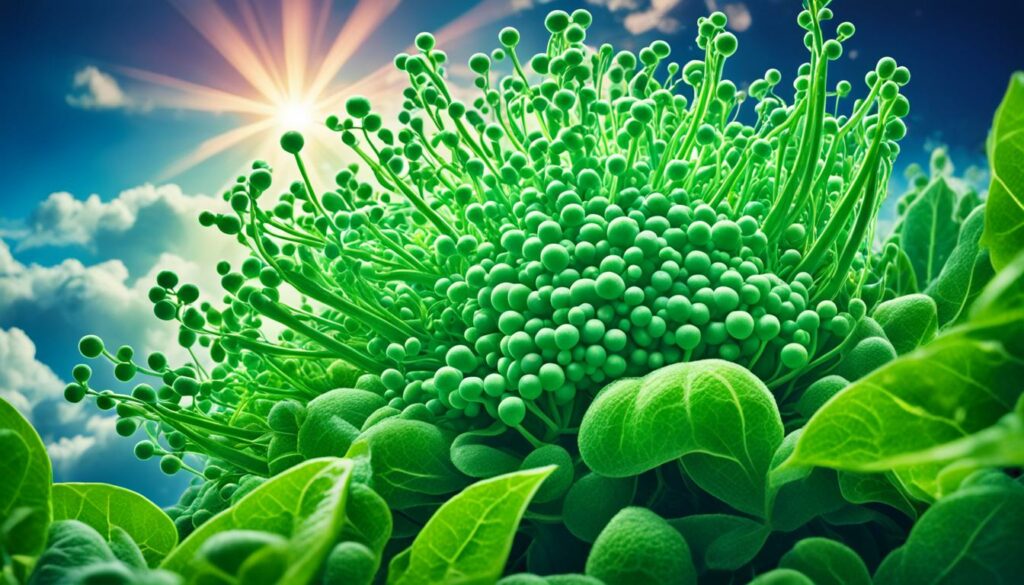
Regulation of Cell Division
Cytokinins control cell division by affecting gene expression. They help with the creation of new plant tissues and leaves.
These compounds also work with other plant hormones. They make sure cells grow and differentiate properly, allowing the plant to grow well.
Impact on Apical Dominance and Shoot Growth
Cytokinins help with apical dominance, where the main shoot grows more than side shoots. They counteract auxins, promoting more lateral growth.
This balance changes the plant’s shape, making it more open. This change helps the plant get more light and nutrients, leading to better health and growth.
| Role | Effects on Plant Growth |
|---|---|
| Cell Division Regulation |
|
| Influence on Apical Dominance |
|
Cytokinins Plant Growth and Development
Cytokinins are vital for every step of a plant’s growth. They help start and grow leaves. Then, they help leaves age and fall off.
Influence on Leaf Primordium and Phyllotaxis
At the start, cytokinins have a big impact on leaf growth. They help decide where and how new leave parts form. This also affects how leaves are placed around the plant’s stem.
Determination of Leaf Shape and Morphology
Cytokinins shape how a leaf looks and works. By controlling how cells grow, they make sure leaves help the plant best. They work closely with auxins to give leaves their exact form.
Role in Leaf Senescence
When leaves start to get old, cytokinins step in again. They can slow down this aging. This lets the plant keep making food longer. It’s a big boost for the plant’s health.
Interactions with Other Plant Hormones
Cytokinins are key plant hormones that work together with auxins and ethylene. They help plants grow well by balancing different growth processes. This allows plants to respond smartly to their surroundings.
Between cytokinins and auxins, their play is crucial in managing how plants grow. Auxins help the top part of the plant and its roots grow, while cytokinins boost cell division and shoots.
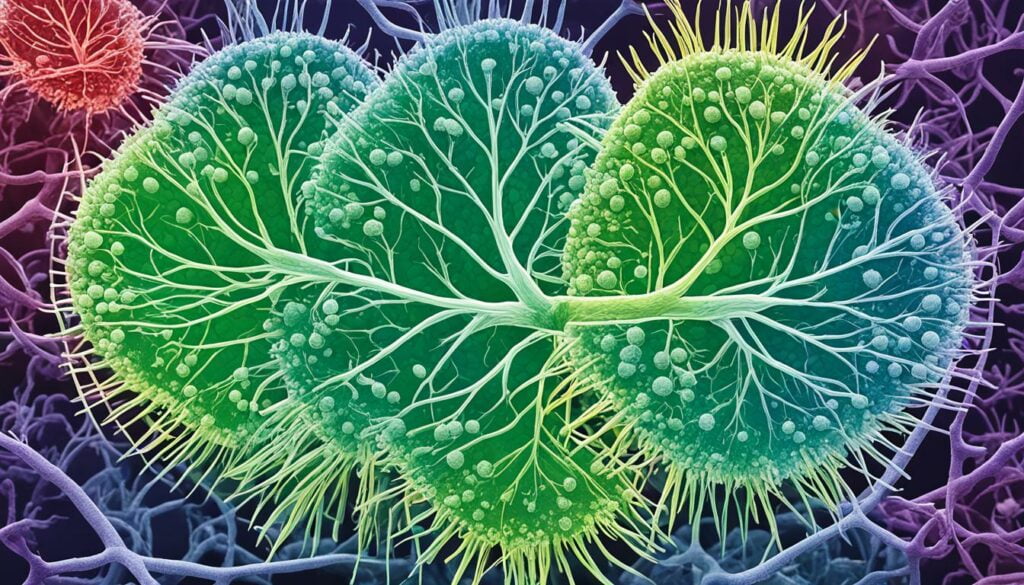
The link between cytokinins and ethylene is vital. Ethylene aids in handling stress and, with cytokinins, controls leaf aging and fruit ripening. This teamwork helps plants thrive even in tough conditions.
- Auxin-Cytokinin Balance: Dictates the formation of shoots and roots.
- Ethylene Synergism: Collaborates with cytokinins to manage stress adaptations.
Studying these complex interactions sheds light on how plants grow and develop. It can enhance farming, leading to better crops that withstand stress.
Cytokinins in Stress Responses
Cytokinins are essential for plants dealing with different kinds of stress. They are crucial for plants to fight off diseases and withstand tough environmental conditions. By managing how plants react to stress, cytokinins help plants stay alive and healthy.
Biotic Stress Responses
In the face of disease or pests, plants adjust their cytokinin levels to protect themselves. These adjustments help in creating substances that kill microbes and making it hard for pests to get in. It shows how important cytokinins are for keeping plants healthy when attacked by diseases or pests.
Abiotic Stress Responses
Cytokinins in abiotic stress are also a key part. They help plants handle dryness, salt, and extreme heat or cold. For example, in droughts, cytokinins keep roots growing and stop leaves from turning yellow. This helps plants survive tough times.
| Type of Stress | Main Cytokinin Role | Impact on Plant |
|---|---|---|
| Biotic Stress (Pathogens, Pests) | Regulation of defense-related genes | Improved resistance, increased production of antimicrobial compounds |
| Abiotic Stress (Drought, Salinity) | Modulation of water loss and ionic balance | Enhanced drought tolerance, delayed leaf senescence |
| Extreme Temperatures | Stabilization of cellular functions | Maintained physiological stability, improved stress resilience |
Cytokinins do complex work in responding to both disease and harsh environments. This work is critical for better crops and healthier plants.
Conclusion
In the big world of how plants grow, cytokinins are key for control and change. They do a lot, helping in making new cells, shaping leaves, and fighting off stress. Cytokinin studies have changed how we see plant behavior and adaptation.
Learning more about cytokinins and how they work with other plant hormones could boost farm output. Scientists aim to use this knowledge to make crops stronger, grow more, and stay healthy despite tough weather.
Exploring the many roles of cytokinins shows a path towards a better, more bountiful tomorrow. This research is not just about plants; it’s also about making our food production sustainable and securing food for everyone on the planet.

